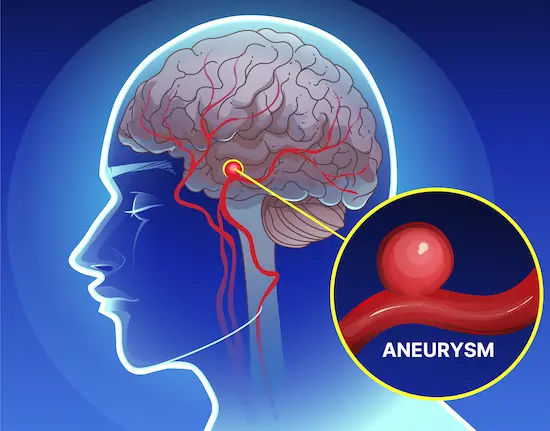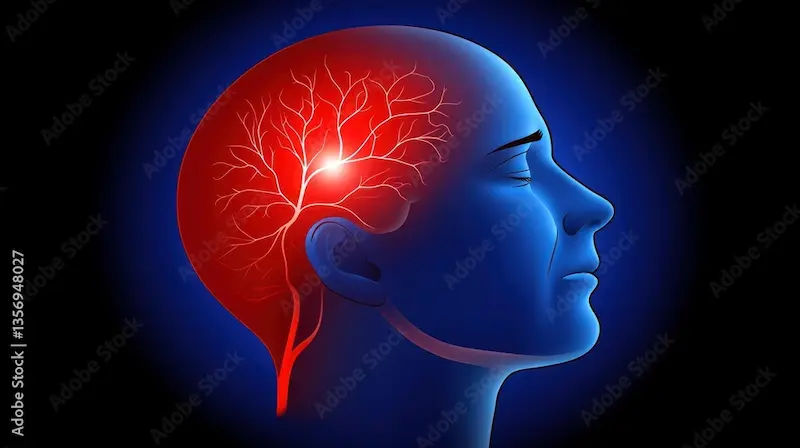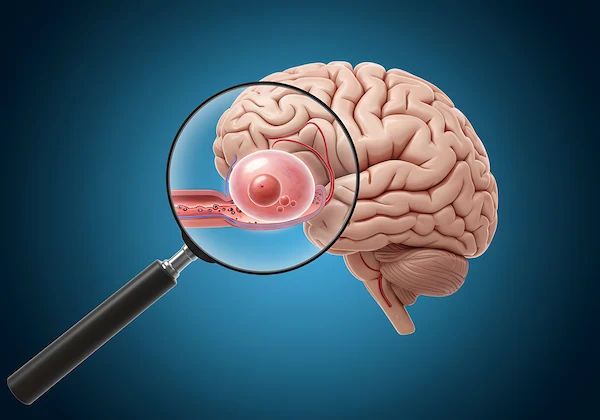What Leads To Signs Of Aneurysms And Types
Learn what leads to the signs of aneurysms, their causes, symptoms, risk factors, and different types. Understand diagnosis and treatment options for timely care.

Written by Dr. Rohinipriyanka Pondugula
Reviewed by Dr. Shaik Abdul Kalam MD (Physician)
Last updated on 8th Sep, 2025

An aneurysm is an abnormal bulge or ballooning in the wall of a blood vessel, most commonly an artery. Arteries are the high-pressure pipelines carrying oxygen-rich blood from your heart to the rest of your body. Over time, pressure can strain a weakened area of the artery wall, causing it to swell outward. This bulge is significantly weaker than the healthy vessel wall and is at risk of rupturing. A rupture is a catastrophic event where the wall tears, causing rapid, massive bleeding that can lead to stroke, shock, or death within minutes. It's important to distinguish a true aneurysm, which involves all three layers of the artery wall, from a pseudoaneurysm or "false aneurysm," which is a contained rupture where only the outer layer holds the blood in.
The Different Types of Aneurysms
Aneurysms are primarily categorized by their location, which greatly influences their symptoms, risk, and treatment.
Aortic Aneurysms: The Body's Main Pipeline at Risk
The aorta is the largest artery in the body, running from your heart through your chest and abdomen. Aneurysms here are among the most common and most dangerous.
Thoracic Aortic Aneurysm (TAA)
This occurs in the part of the aorta that passes through the chest cavity. TAAs are less common than abdominal aneurysms but can be associated with conditions like Marfan syndrome or a bicuspid aortic valve. They often grow slowly and without symptoms, making them difficult to detect without imaging.
Abdominal Aortic Aneurysm (AAA)
This is the most common type of aortic aneurysm, occurring in the part of the aorta that runs through the abdomen. Abdominal aortic aneurysm risk increases significantly with age, particularly in men over 65 with a history of smoking. The U.S. Preventive Services Task Force recommends a one-time ultrasound screening for men in this category.
Cerebral Aneurysms: A Threat in the Brain
Also known as brain aneurysms, these occur in the arteries at the base of the brain. They are often small and cause no issues, but a rupture leads to a subarachnoid hemorrhage, a type of hemorrhagic stroke.
Saccular (Berry) Aneurysm
This is the most common type of cerebral aneurysm, making up about 90% of cases. It resembles a small, round berry hanging from a stem off the main artery. These are most often found at branch points in the brain's arteries.
Fusiform Aneurysm
This type involves a widening of the artery on all sides, forming an elongated, spindle-shaped bulge rather than a sac. It is less common than a saccular aneurysm but can still pose a significant risk of rupture or clot formation.
Peripheral Aneurysms: Less Common Locations
Aneurysms can also form in other arteries, such as behind the knee (popliteal artery), in the groin (femoral artery), in the neck (carotid artery), or within the spleen. While a rupture here is less immediately life-threatening than in the aorta or brain, it can cause serious complications like blood clots and limb ischemia.
Consult a Top Specialist
What Causes an Aneurysm to Form?
The primary culprit is a weakness in the wall of an artery. This weakness can be congenital (present at birth, such as from a genetic disorder like Ehlers-Danlos syndrome) or acquired over a lifetime. The constant pressure of blood flowing through the artery pushes against the weakened spot, causing it to stretch and bulge further.
Recognizing the Signs: Symptoms of an Aneurysm
The most challenging aspect of aneurysms is that they are often asymptomatic until they become very large, leak, or rupture. Many are discovered incidentally during tests for other conditions.
Symptoms of an Unruptured Aneurysm
If a large aneurysm presses on surrounding nerves or tissues, it can cause symptoms. For a large brain aneurysm, this might include a localized headache, eye pain, vision changes, or a dilated pupil. A large AAA might cause a deep, constant pain in the abdomen or back, or a throbbing sensation near the navel.
The Emergency of a Rupture: Symptoms of a Burst Aneurysm
This is a medical emergency. What does a brain aneurysm feel like when it ruptures? Patients often describe it as a "thunderclap" headache, the worst headache of their life, accompanied by nausea, vomiting, stiff neck, blurred vision, sensitivity to light, seizure, or loss of consciousness. A ruptured AAA causes sudden, intense, and persistent abdominal or back pain, dizziness, rapid heart rate, clammy skin, and shock. If you or someone else experiences these brain aneurysm warning signs or sudden severe abdominal pain, call for emergency help immediately.
How Are Aneurysms Diagnosed?
Since they are often silent, diagnosis usually relies on imaging scans. For suspected brain aneurysms, a CT scan, CT angiography (CTA), or MRI is used. For aortic aneurysms, an ultrasound is the most common and effective screening tool. Other diagnostic methods include echocardiograms (for TAAs) and angiography. If you have a strong family history or multiple risk factors, discussing screening options with a doctor is crucial. Apollo24|7 offers a convenient home collection for tests like lipid profiles and HbA1c that help assess underlying risk factors like cholesterol and diabetes, which are linked to aneurysm formation.
Treatment Options: Monitoring and Intervention
Not all aneurysms require immediate surgery. Small, asymptomatic aneurysms are often managed with "watchful waiting," which involves regular imaging to monitor for growth, coupled with aggressive management of blood pressure and lifestyle changes (like quitting smoking).
For larger or growing aneurysms, two main surgical options exist:
1. Open Surgery: The traditional approach where the surgeon repairs the artery by clipping a cerebral aneurysm or replacing the damaged section of the aorta with a synthetic graft.
2. Endovascular Repair: A less invasive procedure where a surgeon threads a catheter through an artery to the site of the aneurysm. For an aortic aneurysm, a stent-graft is deployed to reinforce the weak spot. For a brain aneurysm, tiny platinum coils are placed into the bulge to block blood flow and cause it to clot (coiling).
Can You Prevent an Aneurysm?
You can't change your age or genetics, but you can drastically reduce your risk by managing the factors that weaken your arteries:
Don't smoke or use tobacco products.
Control your blood pressure through diet, exercise, and medication if prescribed.
Manage cholesterol to prevent atherosclerosis.
Eat a heart-healthy diet low in saturated fat and sodium.
Exercise regularly.
If you have a family history of aneurysms or exhibit multiple risk factors, consult a doctor online with Apollo24|7 for further evaluation and to discuss a personalized prevention and screening plan.
Conclusion: Knowledge is Power
Aneurysms are formidable due to their silent nature, but they are not undetectable or unmanageable. Understanding the types from abdominal and thoracic aortic to cerebral empowers you to grasp the risks. Recognizing the causes, such as hypertension and smoking, provides a clear roadmap for prevention through lifestyle changes. Most importantly, being aware of the potential signs of aneurysms, especially the catastrophic symptoms of a rupture, can save a life. Proactive health management, including regular check-ups and controlling blood pressure, is your first and best defense. If you fall into a high-risk category, don't wait for symptoms to appear. Seek medical advice and get screened. Your vigilance today could prevent a crisis tomorrow.
Consult a Top Specialist
Consult a Top Specialist

Dr. Rajib Ghose
General Physician/ Internal Medicine Specialist
25 Years • MBBS
East Midnapore
VIVEKANANDA SEBA SADAN, East Midnapore

Dr. Sougata Kumar
General Practitioner
8 Years • MBBS
East Midnapore
VIVEKANANDA SEBA SADAN, East Midnapore

Dr. Abhishek Ranjan
General Practitioner
4 Years • MBBS
Kolkata
VDC Clinic, Kolkata

Dr. Tapabrata Ray
General Physician/ Internal Medicine Specialist
4 Years • MBBS,DGM,CPMeC,ACMDC
Kolkata
MCR SUPER SPECIALITY POLY CLINIC & PATHOLOGY, Kolkata

Dr. Gopal Hajare
General Physician/ Internal Medicine Specialist
8 Years • MBBS, DNB GENERAL MEDICINE,MNAMS ( MEDICINE ) FACEE
Pune
Apollo Clinic, Kharadi, Pune
More articles from Aneurysm
Frequently Asked Questions
1. Can stress cause an aneurysm to rupture?
While stress can temporarily spike your blood pressure, there is no direct evidence that everyday stress causes an aneurysm to form or rupture. However, chronic, unmanaged high blood pressure is a major risk factor for both the development and potential rupture of an aneurysm.
2. What is the typical aneurysm rupture survival rate?
Survival rates vary greatly depending on the location of the aneurysm, the speed of treatment, and the patient's overall health. For a ruptured brain aneurysm, about 40% of cases are fatal within the first 24 hours, and many survivors have lasting complications. A ruptured AAA has a survival rate of about 20% if managed outside a hospital and 50% or higher with rapid surgical intervention.
3. Are there any warning signs years before a brain aneurysm ruptures?
Typically, no. Unruptured brain aneurysms rarely show warning signs. In rare cases, a very large aneurysm might press on a nerve and cause symptoms like a dilated pupil or eye pain, but most provide no warning. This is why managing risk factors is so important.
How quickly can an aneurysm grow?
The growth rate is highly variable. Some remain stable in size for years, while others may grow gradually (1-2mm per year). A sudden increase in growth rate can be a red flag that requires intervention. This is why regular monitoring via imaging is essential for known aneurysms.
5. Is an aneurysm the same as a stroke?*
No, but they are related. An aneurysm is a weak spot in an artery. If it ruptures in the brain, it causes a hemorrhagic stroke (a bleed into the brain). A stroke can also be ischemic, caused by a clot blocking blood flow, which is a different mechanism entirely.




